The purpose of this test was to explore how my 580ex would handle a fill flash situation. I picked a location with a mix of sunlight and shade, using my white wash rag as my exposure guide. The goal here wasn't perfect exposure but rather to see how the camera defaults I normally use would handle the scene. The shots below are straight out of the camera with resizing and sharpening only.
I started by shooting a couple of control shots with ambient only in Av mode at f/4 and ISO100, letting the camera select the shutter speed based on the evaluative metering. I used multi-point focus which evaluative metering utilizes for determining ambient metering:
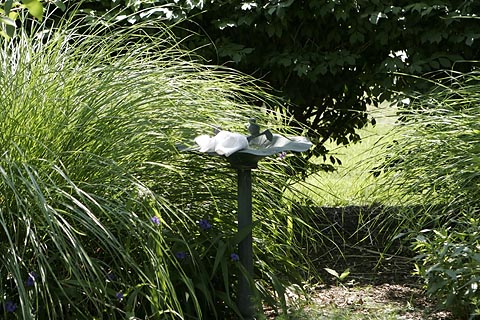
In the wide shot the metering selected 1/160th sec at f/4. The overall exposure is pretty good, but the highlights in the white rag are blown out. That is pretty typical of how evaluative metering will handle an overall dark scene. Were I going for perfect exposure of the rag I'd use the entire viewfinder like a spot meter, as shown in the shot below.
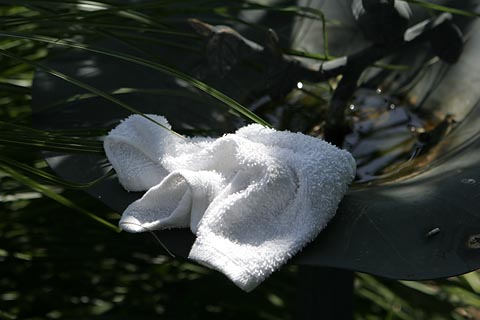
Here I moved in closer and filled the frame with the towel so it dominated the metering. The camera, seeing more light changed the shutter speed to 1/640th resulting in a better exposure of the white towel. The lesson here is to fill the frame with what is the most critical element in the photo which needs correct exposure when metering the ambient light. Were I exposing the scene for wide shot I would note the reading in the Av test shot, but then switch the camera to M at f/4 @ 1/640th to lock in the exposure.
I could have switched metering modes to partial, but I find it easier to evaluate from a consistent baseline of one metering mode. I stick with evaluative because it is the most intelligent mode, applying program logic to make sense of the data from the 35 metering zones and 9 AF points.
With the ambient baseline test completed I turned on the flash. I used a single 580ex on a bracket in direct ETTL mode and shot crops identical to the ambient shots:
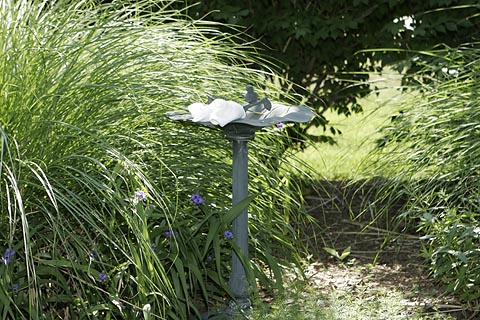
Here the camera again selected 1/160th for the shutter speed with the same results; slightly overexposed highlights in the towel. The difference between this shot and the ambient only one is the increase in shadow detail. It is more evident in the close-up shot below:
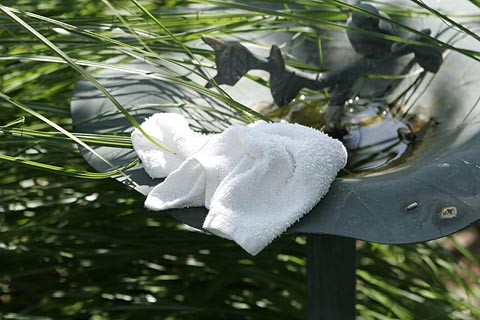
Here the camera selected 1/250th sec. A faster shutter speed was needed for correct exposure but the flash was set in normal mode and the x-sync limit kicked in and kept the shutter at 1/250th. But the flash also compensated for this automatically reducing the amount of fill flash which was added.
Compared to the metering of the ambient only shot where the camera selected 1/640th as the shutter speed I would expect this shot at 1/250th to be grossly overexposed. But there's obviously something going on with the evaluative metering which isn't reflected in the EXIF data.
A Second Flash is Added
Next I added a second off camera flash to the right of the scene and flipped the switch on the one on the camera bracket from "OFF" to "MASTER". I wouldn't normally put a flash there on the shadow side, but the second part of the two light test was to see how the flash could overpower the sun.
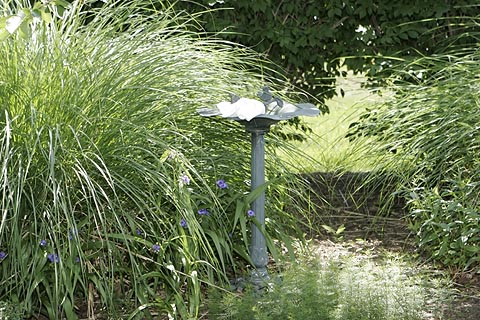
The camera selected 1/125th for the shutter speed here so a combination of intentional cross lighting with the off camera and the overexposure pretty much obliterated the detail in the towel. The flash ratio was set to A:B = 1:2
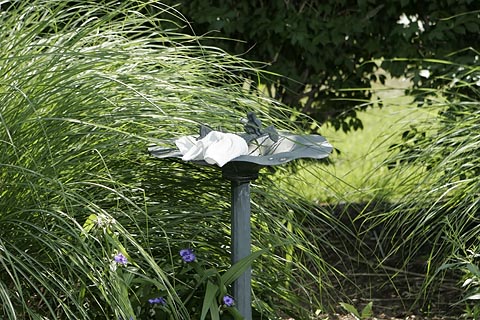
For this closer shot the camera, still set in Av mode and EC and FEC = 0 selected 1/200th as the shutter speed darkening the background a bit relative to the wide shot above. There is also a bit more detail in the white rag, but that is likely due it being larger in the frame and weighting the flash evaluation more, not the change in shutter speed.
Switching to High Speed Focal Plane (FP) Mode
At this point I decided to dial in some minus EC to darken the ambient background. In Av mode a minus EC adjustment increases the shutter speed and with the flash in normal mode regardless of how much I dialed in the shutter could not go faster than 1/250th. So I pressed the button on the flash and switched it to High Speed FP and dialed in - 2 EC.
High Speed overcomes the x-sync limit by pulsing the flash in sync with the shutter curtains as the slit they form at fast speeds travels across the sensor. That cuts flash output in half but in this case I was using two flashes with the off camera flash about 8ft from the towel and that wasn't a problem at f/4:
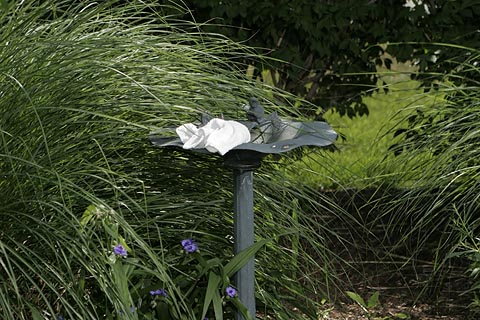
Freed from the x-sync limit the Av metering selected 1/640th sec. because of the -2 EC I dialed in. You might notice that 1/640th is the same shutter speed the camera selected for the ambient only close-up shot. The increase in shutter speed darkened the background quite a bit, but did not affect the flash lit foreground much. That is normal.
Switching to Manual Camera Mode
I wanted to take the background darker, to see if the flash in its lower power high speed FP mode could still overpower the sunlight. I switched the camera to M mode, keeping the aperture at f/4 but shortening the shutter speed to 1/2000th sec. I boosted the ratio to 1:8 so the off camera flash on the right was producing most of the light.
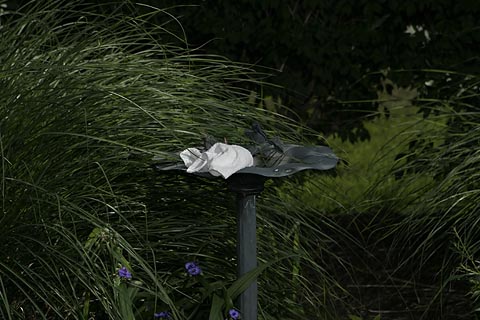
Here the white rag is finally not overexposed. In fact it is slightly underexposed because the 1/2000th shutter speed also affected the flash exposure. In theory it shouldn't but in practice it does.
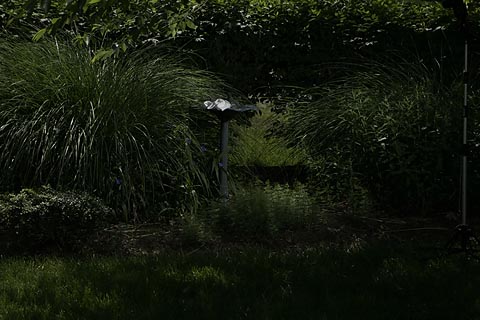
This is a wide shot a the same 1/2000th shutter speed. The flash hasn't totally overpowered the sunlight, but it has created an interesting surreal night-in-day look to the lighting.
How far away does the wireless actually work?
Canon wireless seems to get a bad rap about its range outdoors so for this test I wanted to see how far away it would work. Many people seem to have the impression it uses IR light for signaling but it actually uses pulses of visible pre-flash.
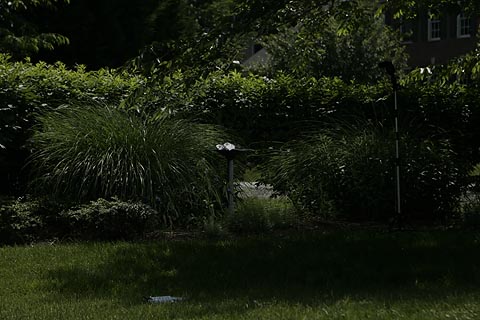
Here I shot from about 35 feet away using the same settings as above: ETTL, 1:8 ratio at f/4 and 1/2000th. The off-camera flash providing the light can be seen in the photo on the right The off camera sensor is shaded so there wasn't any problem firing the slave. But problems would likely occur if the sensor of the slave was blinded by direct sun. But then you'd be blind by direct sun in your eye too. The solution to using the 580ex outdoors appears to be simple; shade the sensor on the slave.
The photo below is the same file adjusted with the brightness control in DPP until the brightest part of the white rag read 254.254.254, just below clipping. A plus one (+1) correction was needed indicating the file was about 1 stop underexposed.
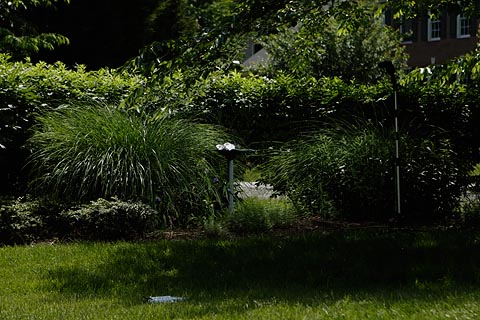
Conclusions?
I've got a pragmatic approach to any TTL metering; I don't expect it to be perfect and am not disappointed when it isn't. The reason I do baseline testing like this is so I can understand and anticipate how the flash will react.
When shooting the test shots above I could tell from the presence or lack of an overexposure warning on the white rag in the playback that the exposures were over or underexposed. I didn't correct because the purpose of the test was to evaluate how well the default evaluative ambient / evaluative flash / multi-point AF did at evaluating the scene.
From this test I now know that the camera will tend to overexpose small light areas on dark backgrounds and underexpose when high speed FP mode is used at very fast shutter speeds. Knowing what to expect I'll be better prepared in similar situations to make the needed adjustments to EC and FEC.
Holistic Concepts for Lighting
and Digital Photography
This tutorial is copyrighted by © Charles E. Gardner. It may be reproduced for personal use, and referenced by link, but please to not copy and post it to your site.
You can contact me at: Chuck Gardner
For other tutorials see the Tutorial Table of Contents